Elevating the forensic laboratory performance
Application of the SCIEX Triple Quad™ 3500 LC-MS/MS System for rapid analysis of drugs of abuse
Oscar G. Cabrices1, Xiang He1, Alexandre Wang1, and Adrian M. Taylor2
1SCIEX, USA; 2SCIEX, Canada
Abstract
Forensic laboratories require powerful tools to quickly and comprehensive analyze their diverse samples. LC-MS/MS operated in Multiple Reaction Monitoring (MRM) mode enables the quantitation of low levels of multiple classes of drugs of abuse in biological matrices. Here, a fast, robust method has been developed for comprehensive analysis of forensic drugs in urine samples using the SCIEX Triple Quad 3500 System. Fast polarity switching, time scheduling of MRM transitions enables fast run times (6.5 mins). A simple urine hydrolysis process was used.
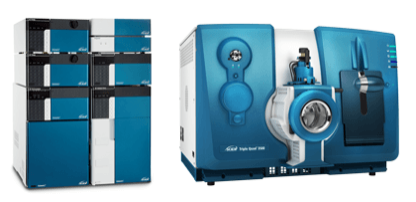
Introduction
Forensic Laboratories around the world share a common objective: to quickly complete their case investigations after receiving a sample (e.g., Driving Under the Influence). GC-MS has long been the technique of choice for illicit drug analysis. Nonetheless, extensive sample preparation is required as well as multiple lengthy analysis methods to achieve the required selectivity and sensitivity. This often increases sample turnaround time, and results in large case backlogs.
Liquid Chromatography coupled to Tandem Mass Spectrometry (LC-MS/MS) offers a significant benefit to forensic investigators by providing the simultaneous analysis of multiple classes of drugs of abuse. This analytical tool operated in Multiple Reaction Monitoring (MRM), enables the quantitation of low levels of compounds in biological matrices, often with much reduced sample preparation and analysis times.
In this study a rapid and reliable method for the comprehensive analysis of forensic drugs in urine samples using the SCIEX Triple Quad 3500 LC-MS/MS System is described. Owing to the inclusion of several barbiturates in the method which efficiently ionize in negative mode, a polarity switching method has been implemented. Due to a high number of MRM transitions (Over 200 MRMs, including the internal standards) and a short LC runtime (6.5 min), an optimized Scheduled MRM Algorithm is used.
Figure 1. Rapidly analyze multiple classes of drugs of abuse from a single injection. Extracted Ion Chromatograms showing the comprehensive analysis of forensic compounds mixed in a urine sample. A rapid polarity switching method is used to include THC-COOH and Barbiturates (Bottom) using negative electrospray ionization, as well as other drugs (Top) that ionize well in positive electrospray mode.
Features of the SCIEX Triple Quad 3500 LC-MS/MS System for forensic drug analysis
|
Methods
Sample preparation: Calibration curves and QCs with a mix of known compound standards (Cerilliant, Round Rock, Texas) were prepared in human drug free urine. The Internal Standards used were: 6-MAM-d3, Amphetamine-d5, Benzoylecgonine-d3, Buprenorphine-d4, Carisoprodol-d7, Codeine-d6, Fentanyl-d5, Hydrocodone-d6, Hydromorphone-d6, JWH 018 4-OH pentyl-d5, JWH 019 6-OH hexyl-d5, MDPV-d8, Meperidine-d4, Mephedrone-d3, Meprobamate-d7, Methadone-d3, Methamphetamine-d5, Methylone-d3, Mitragynine-d3, Morphine-d6, Nordiazepam-d5, Nortriptyline-d3, Oxycodone-d6, Oxymorphone-d3, THC-COOH-d3, Butalbital-d5, Secobarbital-d5 These were mixed and diluted in methanol as the IS spiking solution. The sample preparation workflow used in this study is detailed in Figure 2.
LC conditions: HPLC separation was performed on Phenomenex Kinetex Phenyl-hexyl (50 × 4.6 mm, 2.6 mm, 00B-4495-E0) on the SCIEX ExionLC™ AC System. Mobile phase A (MPA) and mobile phase B (MPB) were ammonium formate in water and methanol with formic acid, respectively. The LC flowrate was 1 mL/min, and the total LC runtime was 6.5 min. Injection Volume was 20 mL.
Figure 2. Urine sample preparation workflow. A straightforward urine hyrdrolysis was for glucuronide-conjugated analytes for comprehensive forensic drug analysis with the Triple Quad 3500 LC-MS/MS System.
MS and MS/MS conditions: Data was acquired using the SCIEX Triple Quad™ 3500 LC-MS/MS System. The key parameters were: Curtain gas (CUR) - 30, Collision gas (CAD) - Medium. IonSpray Voltage (IS) - 2500 V (positive) and -4500 V (negative). Temperature (TEM) - 650°C. Ion Source Gas 1 (GS1) - 60. Ion Source Gas 2 (GS2) - 50. The Declustering Potential (DP), Collision Energy (CE), and Collision Cell Exit Potential (CXP) voltages were optimized for each individual component, as described in Table 1.
Data Processing: Data was acquired with Analyst® Software 1.6.3 and processed with MultiQuant Software 3.0. Linear dynamic range was evaluated through calibration curves with analyte concentrations ranging from 1-1000 ng/mL.
Table 1. List of the target compounds analyzed in a single method using the Scheduled MRM Algorithm.
Implementing a rapid and selective comprehensive drug analysis method
Using the Phenomenex Kinetex Phenyl-Hexyl column enabled the rapid separation of various isobaric compounds targeted in this method. Under the conditions used, peak front-tailing for early eluting compounds like gabapentin, morphine and oxymorphone was not noticed. Figure 3 shows the LC separation of several forensic isobaric compounds targeted in this method.
The optimized Scheduled MRM algorithm in Analyst Software 1.6.3 ensured optimal data quality even during regions of the chromatogram when the MRM concurrency was very high. Most MRM transitions had 15 or more data points across the LC peaks. A minimum of 10 data points was achieved across every peak.
Figure 1 shows the elution profile of all the compounds, in which the top trace shows the extracted ion chromatograms (XICs) for the barbiturates and THC-COOH (negative mode) and the bottom trace the XICs for the remaining compounds in positive mode.
It was essential to employ rapid polarity switching to accommodate more all the analytes (more than 200 MRM transitions) within a single, rapid data acquisition method. Compared to two separate injections (one for each polarity), this rapid polarity switching method offers a significant improvement in sample throughput.
Figure 3. Obtain complete separation of isobaric compounds. The combination of the selectivity of the Phenomenex Kinetex Phenyl-Hexyl column and speed of the Scheduled MRM Algorithm enable the separation and definite analysis of compounds that share the same MS/MS characteristics.
Forensic analysis methods for drugs of abuse using GC/MS range between 15-17 minutes per sample, due to analyte volatility, derivatization technique, capillary column dimensions, carrier gas flow rates and physicochemical properties. In the current LC-MS/MS method the runtime was approximately 6.5 minutes to accommodate all drugs of abuse in the same run. With a smaller target list (e.g. < 60 analytes), the LC runtime can be reduced to approximately 5 minutes or even further with the additional LC separation pumps, column switching valves as part of the LC multiplexing capabilities of the MPX™ Software. Figure 4 shows the Sample throughput comparison of the SCIEX Triple Quad 3500 LC-MS/MS System and GC/MS. More than 285 samples can be processed within a 24 hour time frame using a 5 minute LC run, which would significantly help the forensic laboratory increase sample turnaround time, and reduce large case backlogs. |
Table 2. Drug analysis method sample throughput comparison.
Figure 4. Maximize laboratory sample throughput. The combination of all target compounds in a comprehensive LC-MS/MS method helps the performance of the forensic laboratory by analyzing more than 280 samples within a 24 hour period. |
Analytical performance of the SCIEX Triple Quad 3500 LC-MS/MS System for forensic drug analysis
The processed urine sample had a final dilution factor of 10. With only 20 mL injection volume (equivalent of 2 mL unprocessed urine), all compounds were detected with ease. Limits of Quantitation (LOQ) ranged between 1 to 100 ng/mL, depending on compound class. Figure 5 shows a few representative calibration curves generated with this comprehensive method.
In addition to the good linearity obtained, method reproducibility was evaluated across the entire concentration ranges assessed. Figure 6 shows representative XICs of the quantifier MRMs of notable drugs of abuse and metabolites measured in this method (THC-COOH, Methadone and Norfentanyl).
Three replicate set of injections were performed, obtaining excellent reproducibility with RSD values less than 10% for most compounds. All quantitation results were processed with MultiQuant Software 3.0, designed for easy, quick, versatile and streamlined data processing with accurate and reliable quantitation.
Figure 5. Good Linearity was Achieved for Drugs of Abuse in Urine Samples. Calibration curves are shown for 6-MAM (top) and PCP (bottom) R2 values were equal to 0.99 all compounds in the comprehensive method.
Figure 6. Excellent reproducibility was achieved for drugs of abuse in urine. Representative XIC traces of different forensic compounds are shown to demonstrate reliable quantitation at different concentrations.
Conclusions
A rapid and comprehensive analysis method for the LC-MS/MS analysis of drugs of abuse in urine samples was developed using the SCIEX Triple Quad 3500 LC-MS/MS System, enabling the platform to be readily adaptable by forensic laboratories.
- The combination of the selectivity of the Phenomenex Kinetex Phenyl-Hexyl column, speed of the Scheduled MRM algorithm and rapid polarity switching enable the rapid separation and definite analysis of forensic compounds.
- The combination of all target compounds in a comprehensive LC-MS/MS method maximizes laboratory sample throughput with more than 285 samples processed within a 24 hour time frame.
- Successful quantitative analysis was achieved through MultiQuant Software 3.0 enabling streamlined and accurate data processing of the all compounds analyzed. Excellent linearity and reproducibility were observed for all analytes across the relevant calibration range.
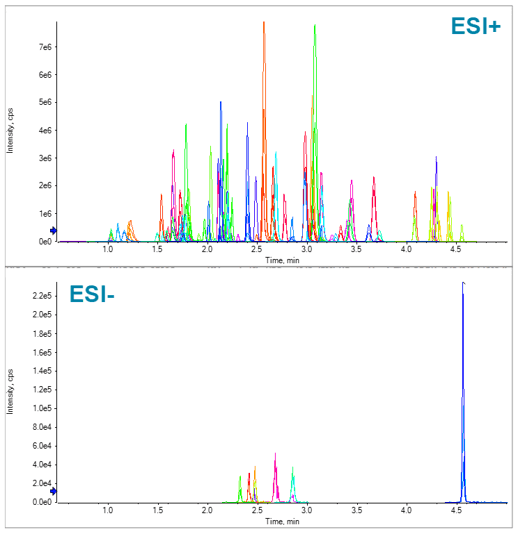 Click to enlarge
Click to enlarge Click to enlarge
Click to enlarge Click to enlarge
Click to enlarge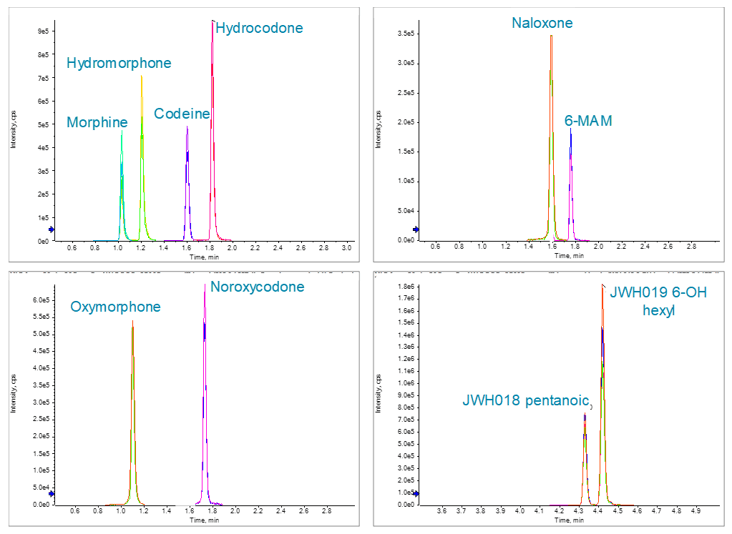 Click to enlarge
Click to enlarge Click to enlarge
Click to enlarge Click to enlarge
Click to enlarge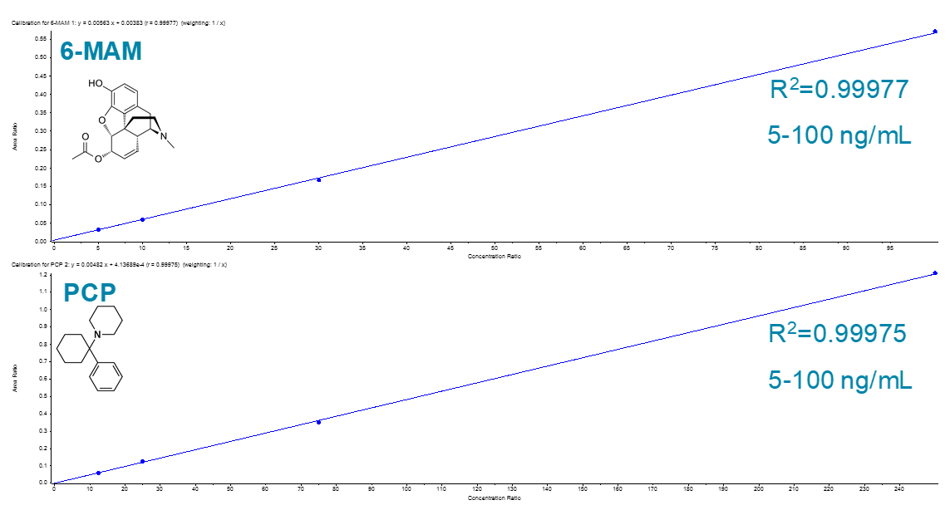 Click to enlarge
Click to enlarge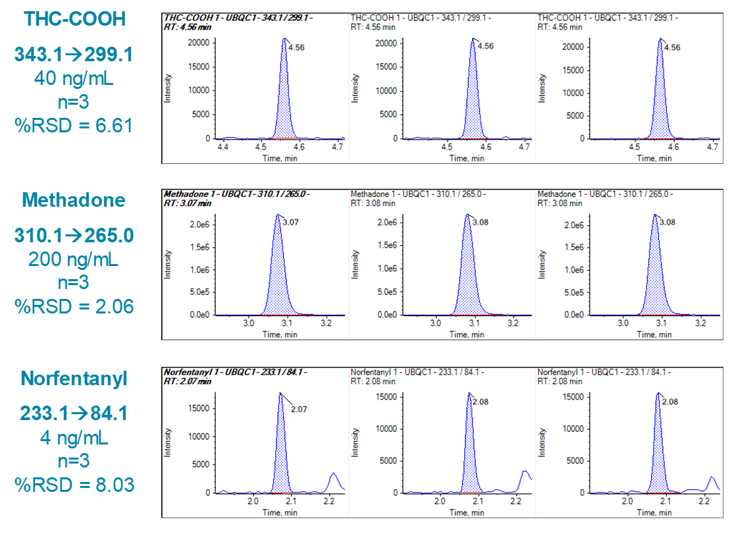 Click to enlarge
Click to enlarge